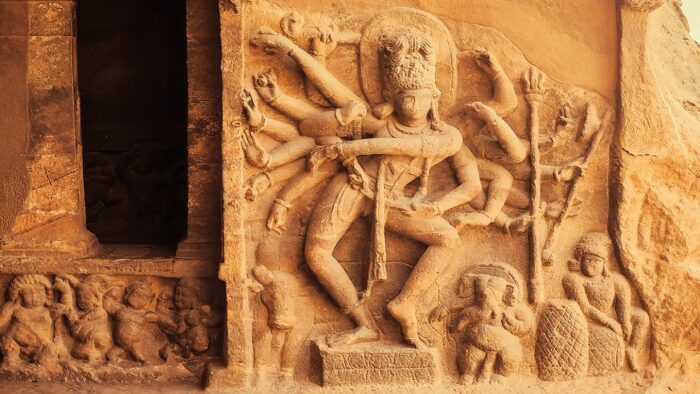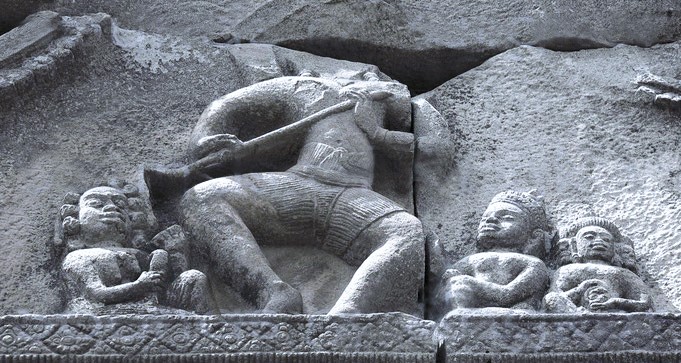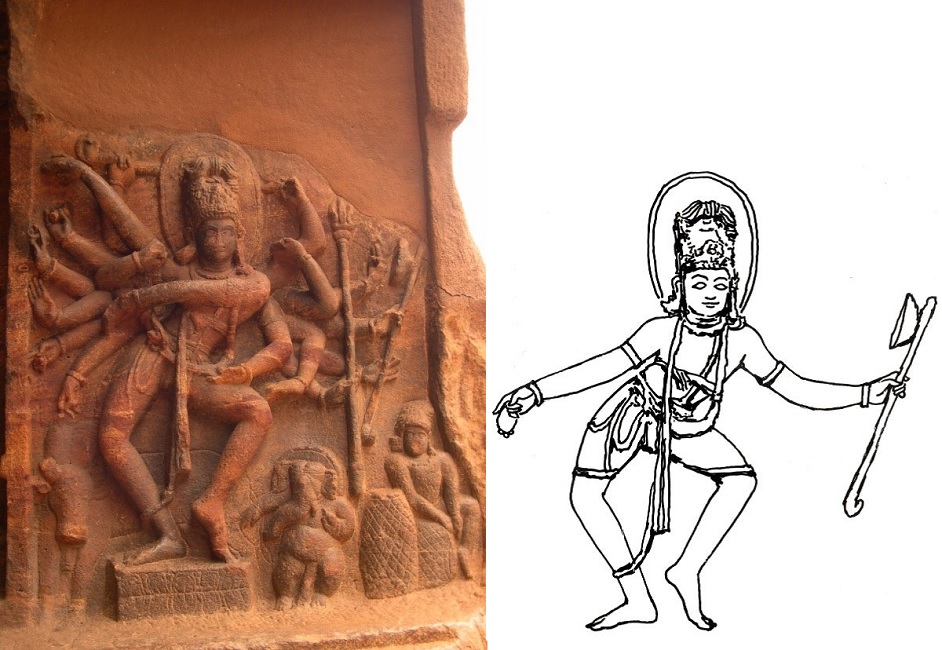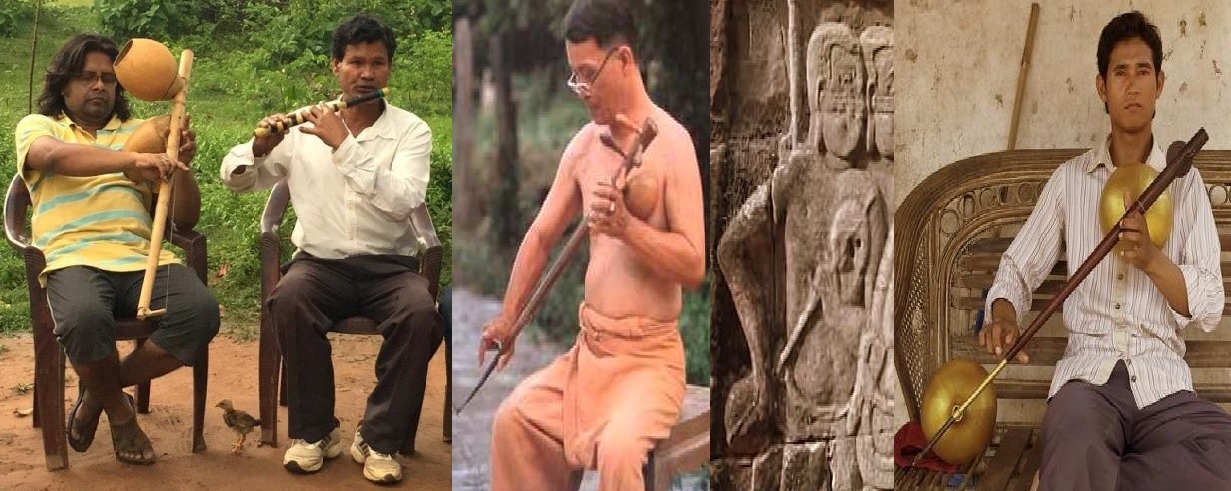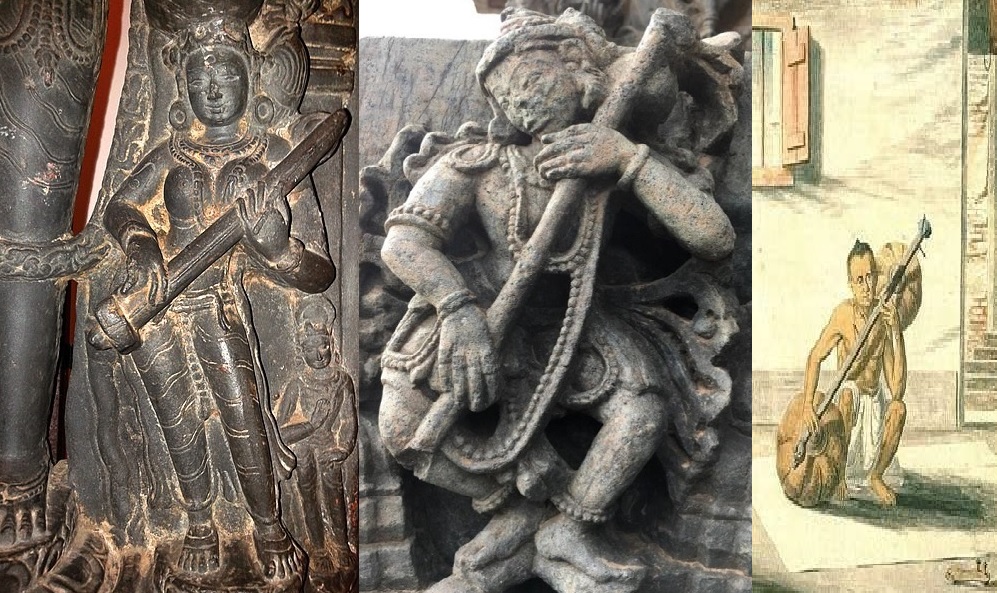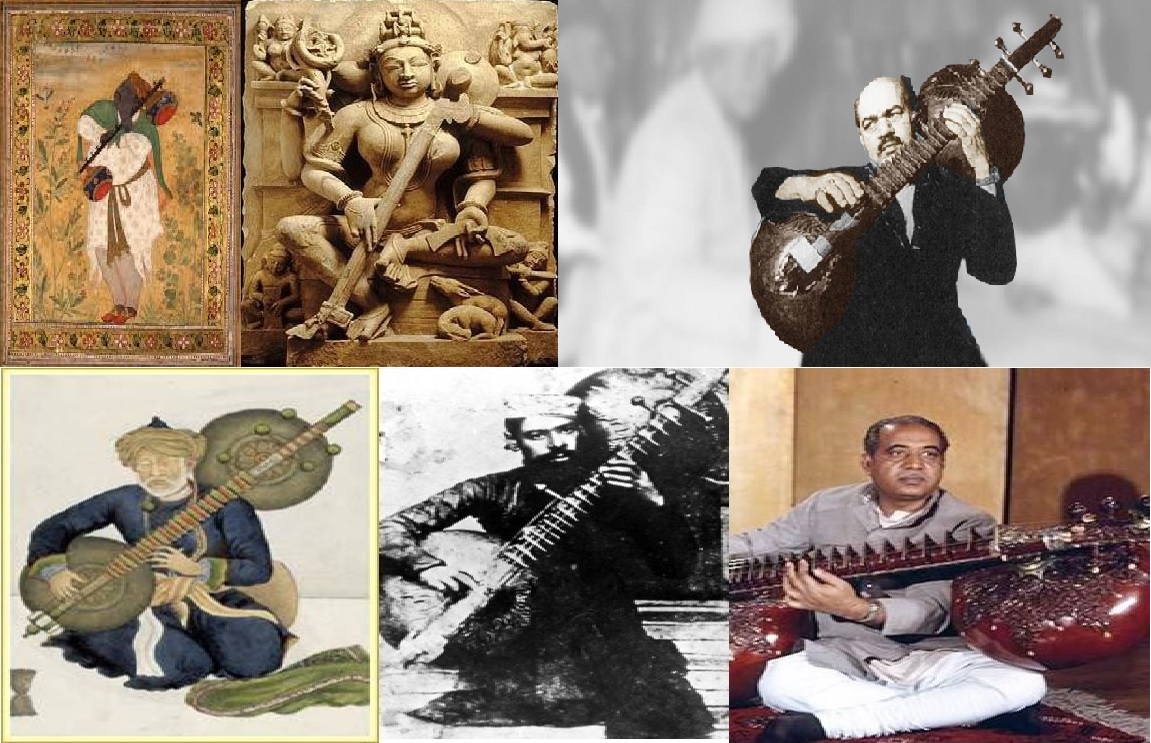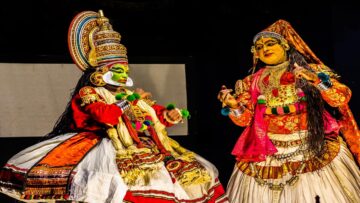The study is conducted within the scope of Śaiva Iconography and Metaphysics by Parśvadeva (13th Century)
Introduction
The Indian Rāga system is borne out of Aṣtadaśā Jāti of Nātyaśāstra that finds its origin in the realization of Brahman through the practice and study of Sām Vēda. This foundational philosophy forms the basic connection to the metaphysics followed for the music system in India. Saṅgītakara1 Parśvadeva was a Digambara Jain Āćarya, popularly known as an atheist. He specifically mentioned that Śṇkara/Śiva can only be realized through music as it is Nādatmaka2 (referring to the unmanifested primordial universal soundscape). In the sixth chapter of Saṇgīta Samaysāra while explaining the importance of Ēka-tantrī Vīn̟ā he has used the term “शङ्करोक्तद्विधवाद्यम्”. This directs to the interconnection of Śaiva philosophy with One-String Zither. Scholars mistake his acceptance of these facts with his allegiance towards Hindu school of thought. Actually, an extensive research reveals that all the musicology literature and iconographical references suggests that One-String Zither is an important aspect of the concept of Śiva or Ultimate Reality or Non-dualism. Even in the neighbouring countries of south-east Asian origin One-String Zither is synonymous with the concept of Śiva. Relics and sculptures of these countries are replete with iconographical references that points towards their direct relation with the concept of Śaivism. Additionally, Śastra-ic literature and literature on musicology both represent Indian worldview that firmly establishes the interconnectivity of philosophy and any disciplined systemic practice. This is because these literatures do not just speculate but documents a praxis, an established method of practice and a school of thought.
Vedanta propagates the idea of the origin of the Universe from the Brahman or Atman. There are various passages that would aid in the understanding of the Brahman. But before the comprehension of Brahman it is important to understand, what is meant by Brahman. A comparative study of Para Advaita philosophy reveals that both Vedanta and Śaivagama imply Ultimate Reality as Brahman, which is the Svaprakāśa or Self-luminous by dint of Self-knowledge in Vedanta and Prakāśa –Vimarśa (Self-Presentative Activity), an additional quality of Self-awareness along with Self-knowledge in Śaiva philosophy. The knowledge of Brahman can be acquired by two approaches – Saguna Brahman and Nirguna Brahman. According to Thakur Jaidev Singh both these concepts are same, in Śaivagama only with the difference in nomenclatures Sakala Śiva and Niṣkala Śiva. This categorization of Brahma or Śiva is followed even in the category of One-String Zither. When these philosophies are studied and practically applied in the study of instruments, which are minutely examined along with their living traditional practices, scriptural guidance, foundational philosophy and iconographical and cultural reference exhibits the depth in ancient Indian artistic practices and connects the existing instruments and practices with the metaphysics of Indian worldviews.
Literature review
Not much scholarly research has been conducted to indicate the path towards manifestation of transcendental concept of Brahman through music. There are classical literatures on Musicology, Tattva and few rare books the experience of Nāda Yoga by Yogī-s and practitioners.
Research gap
Nāda Yoga or realization of Nāda and its equation with the concentrated practice of music in Mārga/ Deśī parampara has brought forth many questions and revelations. The quest to understand the state of Nāda Yoga through the prolonged of practice of string instruments led to the understanding of Music as medium or passage to be followed to realize the Absolute Reality, to ascend towards the state of Existence-Consciousness-Bliss. This further led to the extensive study of Śaiva Darśan and minute study of the Vīṇā Lakśnam Paddhati that opened the avenue towards understanding of the metaphysics of music or especially, Vīṇā Vādan and its origin based on the idea of Śiva or non-dualism. Specifically, this study aims at understanding the subtlety of categorizing Vādya based on the yogic concept of Sakala and Niṣkala Śiva that exists in the form of Sakala and Niṣkala Vādya.
Objectives
This exploratory research gravitates towards the existence of the external manifestation of the concept of Ultimate Reality of Śaiva philosophy surviving within the śastra-ic practice of music, both in living and lost traditions of One String Instrument.
- To bridge the gap between Śastra and artistic practice of music.
- To trace the existence of the concept of Brahmā or Śiva in the existing practice of string instruments.
- To understand the categories of Sakala and Niṣkala within the paradigm of darśana, musical manifestation, scriptural guidance and iconographical and cultural reference.
- To preserve and throw light upon the remnants of these living traditions surviving even within the tribes.
Methodology
This is a combination of primary and secondary data to explore the concepts of theology and philosophy within the dynamic practice of music in classical instruments. The following steps were taken to determine the progress of this study. They are:
- Comparative study of classical literature on music, theology, arts and philosophy. Commentaries on music and musicological developments helped shape the view on practice and philosophy.
- Field study of relics, sculptures, architecture and inscriptions for iconographical and cultural reference.
- Acknowledging and examining the practices surviving in living traditions, whether within the tribal communities or within traditional classical practices.
- Practical training and reconstruction along with its theoretical implications that will help to determine a plausible difference that exists between practice and theories, which will act as a springboard for this study to be not limited within the boundaries of scholarly endeavours but to find probable methods to integrate this within today’s classical practices.
- A thorough understanding of Sanskrit language in terms of various nomenclatures and overlapping concepts, which includes Vedic literature such as Śatapatha Brāhmaṇa, Vijñānabhāsya by Motilal Shastri, Nyaya Darśan, Samkhya Darśan, Kaśmir Śaivism, Upanishads to understand its metaphysical aspect.
Importance of One-String Zither in iconographical, scriptural and traditional practices
After a thorough study of Saṅgītsamaysār one may notice that there is no mention of the encyclopaedic commentary on Nātyaśāstra, Abhinavabharati or any admiration towards Abhinavagupta. Additionally, the categorization of string instruments start with Ālāvaṇī Vīn̟ā (One-string Stick Zither) as a category of Ēka-tantrī Vīn̟ā (One-String Tube Zither) without its direct mention while introducing string instruments and its playing techniques.
“वीणा चालावणी चैव किन्नरी लघुपूर्विका ।
वृहत्किन्नरिका चैव शकनीत्यादिकं ततम् ॥४॥”3
A possible explanation can be that the practice of desī system came in vogue which may have made mention of Nātyaśāstra-ic practices as incoherent. This helps to conclude an important point that Ālāvanī Vīn̟ā (One-string Stick Zither) became such an important cultural iconographical instrument that it finds mention as the first string instrument in the scripture as well as in the relics from the era of 6-7th CE. Also, to understand this instrument’s rich culture a similar instrument survives amongst the tribes of Jharkhand and Orissa, known as Tuhilā (One-string Stick Zither).
Ēka-tantrī Vīn̟ā (One-string Tube Zither), in most of the scriptures is considered to be of prime importance. Even Parśvadeva in his Saṅgītsamaysāra has glorified this instrument as the origin that personifies the concept of Nāda (unmanifested primordial sound). This research paved the path to reconnect the existence of elemental similarities between Danda Vīṇā and Rudra Vīṇā. Ēka-tantrī Vīṇā (One String Tube Zither) is another version of Danda Vīṇā that only survives in manuscripts and sculptures. After examining the measurement of the Danda in the major musicology literatures, it points towards the similarities between the Danda of Rudra Vīṇā and Ēka-tantrī Vīn̟ā. But Ālāpinī or Alavani Vīṇā (One-String Stick Zither), another variant of Mono String Zither exists as Tuhila, a primitive One String instrument of the Orao tribes of Jharkhand and Orissa. These One String instruments enjoy a prime position in our culture as well as in the classical texts where it is regarded as the origin of all the lute instruments. Another south-east Asian version exists in Cambodia as Ksa Diev and its significance can be found in the sculptures of the temples of Bayon. The Thai variant is known as Phin Pia where it exists in four strings also. Then comes the Kinnarī Vīṇā in two variants, Mārga Kinnarī (three gourds/sound resonators) and Laghū Kinnarī (two gourds/sound resonators), a medieval fretted lute, which has lost its existence from the classical music practices but survives as Kinnerā Vādyam amongst the Chenchu and Dakkāli tribes of Telengana. There is a Cambodian variant of Ksa Diev, known as Ksa Muoy, which is verisimilar to Laghū Kinnarī and still in vogue. This research provided significant points to determine the chronological transformation and development of Rudra Vīṇā leading to a very important medieval text Nātya Sarvasya Dīpikā where it specifically gives the theoretical explanation in the Ālāpinī Lakshanam of how a medieval Vīṇā was transformed to Rudra Vīṇā and the various elements that are borrowed from the variants of the One-String Zither. Addition of fretts to the lutes brought structural and technical change which further resulted in the change of the playing technique of Vīṇā. The number of frets in the lutes determined the constructional change in the composition of music with the impact on the manifestation of the ‘Svaras’.
The constructional issue is imperative as with the gradual development/ transformation in the instruments of Bharata’s system, namely from the Vīṇās to the ‘Bin-baja’ or Kinnarī to Rudra Vīṇā, one can see the gradual transformation in the manifestation of Nāda or sound-production. This concept and manifestation of Nāda is according to the purpose and construction of the string instrument. A thorough explanation of its metaphysics will be followed by their cultural and iconographical reference.
A surviving tradition of the Ālāpini Vīṇā, in the name of ‘Tuhila’ can be seen within the Mundari tribal community of Jharkhand and Orao Tribes of Orissa. With the last surviving guru of Tuhila, Shree Lalu Shankar Mahali, have worked upon the basics of their tradition and playing techniques. Another two surviving traditions of such instrument can also be found in Cambodia, as ‘Kse diev’, and in Thailand, as ‘Phin Pia’. Both of the instruments received transformations due to the cultural travel across chronotope; whereas Kse Diev remained one-stringed stick-zither (except the installation of a movable peg for attaching string, a metal string and a metal lower-piece acknowledged as ‘Karabha’ in the scriptures), Phin Pia got transformed into a four-stringed stick-zither (with four movable pegs for attaching strings). The way of sitting with these instruments, the holding posture and even the sitting posture with them have a verisimilitude with the scriptural and traditional modes of playing the Ālāpini Vīṇā. Such is also very much evident in the temple sculptures of Cambodia as well.
(Figure 1: Shiva’s Dance, Phnom Chisor, Battambang, 11 century CE, Cambodia)
The importance of this One-String Zither can be taken from the following verses of reverence towards this instrument:
“क्रियाभेदाद् वाद्यभेदात्तथैव व्याप्तिभेदतः।
वीणाभेदाद् भवन्त्यन्ये तन्त्रीसंख्यावशादपि॥१२॥
भजते सर्ववीणानामेकतन्त्री प्रधानताम्।”4
(Figure 2: From left to right: Mahānata, Shaiva Guha number 1, early 7th century CE, Chalukya dynasty, Badami, Bijapur, Karnataka, India, Line drawing of the same sculpture with the One String Stick Zither)
Parśvadeva has given it importance by putting Alavani Vīn̟ā on the first position. This can be called either Alavani or Alāpini Vīn̟ā. Śaraṅgadeva named this as Alapini Vīn̟ā. The word ‘Alavani’ comes from the root ‘Alavu’, which means gourd. This Vīn̟ā has one sound resonator and thus the name. Few scholars in recent times have mistaken this Vīn̟ā as an instrument only for Alāp due to its name as Alāpini Vīn̟ā. It is better not to categorize instruments based on music that has developed within the last hundred years. The non-structural musical precursor conventionally played before any structural musical rendition of any Rāga is known as Alāp. But this method has developed based on the transformation of music and instruments over the past two to three centuries. For example, the Aochār that is performed before any gat on Sitār is somewhat similar to the structure of Alāp. Hence, there are many categories of Alāp and having a myopic stance will be detrimental to a study as such where the instrument belongs to ancient India. Alāp can be of three types: Alāp, Alapti and Alāpanam. These categories also depend on the instrument, number of strings, anatomy, and acoustics and even on the living tradition or parampara. This can be inferred from Ustād Bāhāuddin Dāgar’s statement on the first installation of metal strings on Rudra Vīṇā, ‘mīrdh’ could not be manifested in more than three svara-s unlike today’s developed version where ‘mīrdh’ may reach up to four or five svara-s. It is due to the change in the set up of performance arena, the demand to sustain the sound produced by these instruments for a large space led to the new additions and developments. All these developments took place due to the change in time, taste and habits. After consulting Dr. Karuna Vijayendra, the relics can be traced back to the 6th -7th century CE. He has mentioned that the number of references increases in the 12th-13th century CE with stray appearances in the 16th century CE during the Vijayanagara dynasty. This actually provides the time frame for the comparative study and clears any confusion regarding the function of the instrument otherwise believed to be only for Ālāp.
The Ālāpini Lakśanam (guidelines) by Śaraṅgadeva in his encyclopaedic work on music Saṅgītaratnākara confirms structural similarity with Tuhila.
(दण्डककुभयोः लक्षणम्)11
नवमुष्टिमितो दैर्घ्येवैणवः सुषिरान्तरः।।
अड्न्गुलद्वन्द्वपरिधिः प्राग्वद् ग्रन्थ्यादिवर्जितः।
श्लक्ष्णः समः सुवृत्तश्च दण्डः स्यात् ककुभं दधत् ।।
अड्न्गुलद्वयविस्तारमड्न्गुलार्धायतं तथा ।
तदर्ध पिण्डसंयुक्तमुन्मुखं पत्रिकोज्झितम् ।।
एकदण्डमधोभागे शङ्कुना तु विराजितम् ।
चतुरड्न्गुलदैर्घ्येण बहिर्मधयोन्नतेन च ।।
Before locating the similarity it is pertinent to follow Parśvadeva’s contemporaries and his successors who had given significant place to Alapini Vīn̟ā (One-string Stick Zither). Saṅgīta Dāmodara (C. 1718-1767 CE) by Śrī Śubhaṅkara from Eastern India reveals many similarities between Tuhila and Alapini Vīn̟ā, especially the playing techniques and the types of music. Gajapati Nārāyaṇadeva in Saṅgīta Nārāyaṇa (17thcenuty CE) and even Someśvara in Mānasōllāsa speak highly and explicitly about Alapini Vīn̟ā (One-string Stick Zither).
(Figure 3: From left to right: Piyal Bhattacharya with Tuhila master Lalu Shankar Mahali, Jharkhand, India; A Phin Pia player, Thailand; Sculpture with Ksa Diev, Jayavarman VII Temple, Cambodia and A Ksa Muay player, Cambodia)
When closely observed, its acoustics, anatomy and fingering techniques matches the guidelines of Alavani Vīn̟ā (One-string Stick Zither) suggesting that a primitive version of this instrument survives within a living tradition will help to bridge the gap between scriptures, sculptures and practical approaches. Tuhila is not just a folk instrument, its importance cannot be disregarded just because it has no written guidelines or Śāstra to validate its existence. Its practice survives in a living tradition making it imperative to know this instrument closely and uphold its value within the mainstream cultural context.
Traditional cultural practices along with its methodology began with the tradition of teaching orally but after a considerable amount of propagation and practice leads to its being documented and reflected with the iconographical representation. The same can be concluded of the living tradition of Tuhila amongst the tribe of Jharkhand and Orissa. Therefore, it is the living tradition that helps to chart the path in the right direction with the help of scriptures. The only difference is that it exists in tribal culture in its rudimentary form without structured documentation or scriptures. Nonetheless, it still survives in a living tradition and later further similarities with scriptures will support its existence as a form of Ālāpini Vīṇā.
The Danda of Ēka-tantrī Vīṇā (One–string Tube Zither) and its transformation has contributed to the development of present-day Rudra Vīṇā. These two classical texts provide almost similar scriptural prescription for the structure of Ēka-tantrī Vīṇā (One-String tube Zither). There are minor dissimilarities that can be the result of different Paramparā or practices as imbibed by different Sampradāya or different sects of people. These instruments were practiced traditionally and thus, the differences were based on the traditions carried on by these Sampradāya. Ēka-tantrī Vīṇā, also known as Danda Vīṇā, is mentioned as Ghōśa Vīṇā by Śāraṅgdēva in Saṅgītaratnākara.
“एषाऽपिजनकः प्रोक्ता घोषकश्चैकतन्त्रिका॥”
These bridges the gap between centuries as Ghōśa Vīṇā finds its reference in Bharata’s Nātyaśāstra (2nd century BC-2nd century AD). To prove its importance, Āćārya Abhinavaguptā mentions this as ‘Piśtanaka Vīṇā’ in his commentary.
“…घोषकः पिष्टनका । तौ प्रत्यङ्गौ ॥”
Ēka-tantrī Vīṇā (classical texts) has been given the position of Śudhha vādya or the instrument that produces pure, blissful sound. Thus, this justifies the prime position bestowed upon Rudra Vīṇā amongst all the other classical string instruments.
Though this Vīṇā has lost its practices and its craftsmanship due to social and political impact, but its theoretical and practical reference can be found in the living traditions of our modern Vīṇā-s. The ‘Danda’ or the Tube of the One-string Zither has been transformed over the years to result in the form of Rudra Vīṇā. This link can be found in the scriptures, where the measurement of the tube is given, and the same technique is applied in the structural construction of Rudra Vīṇā.
When Saṅgīta Samaysāra by Āćārya Pārśwadeva is consulted, the Ēka-tantrī Vīṇā is mentioned and its fingering techniques have been given, but the only peculiarity is that there is no description of Ēka-tantrī Vīṇā. Academicians have propounded that around 7th century the culture of India based on Bharata’s Nātyaśāstra migrated to south-east Asia through trade routes. But these cultures were not imposed as such but gradually grew on their existing culture due to similarities in comprehension and analysis of worldviews. Thus, the instruments that travelled to such countries developed based on the essence of their culture with roots from India. Although the tradition of constant practices of Gītā-vādya-nŗtta in the Indian Shaiva and Vaishnava temples in India were welcomed in these countries as well, but they got developed further while delving on the local elements and conditions, primely dependent upon the deśa (space) and kāla (time) of each region and their specific indigenous practices. So, the similarities are not mere replicas but organic entities. Ksa Diev from Cambodia and Phin Pia from Thailand shares the same structural composition as that of Alapini Vīn̟ā. Sculptures in the caves and temples demonstrate their existence and cultural significance.
Another possible explanation can be that the practice of desī system came in vogue which may have made mention of Nātyaśāstra-ic practices as incoherent. This helps to conclude an important point that Alāvani Vīn̟ā (One-string Stick Zither) became such an important cultural iconographical instrument that it finds mention as the first string instrument in the scripture as well as in the relics from that era.
To further clarify the foundational relationship between Ēka-tantrī and Rudra Vīṇā, we can follow the sitting posture in paintings and relics where the sound resonator rests on the shoulder. To establish this point, a sculpture from the Hoysala Temples gives proper indication of this feature. Also, this pattern can be recognized in a painting of 18th century Bengal. Kuplyān-s or Bin is found in Saṅgītanārāyana by Gajapati Nārāyan Dēva (C. 1718-1767 CE) as Kapilāsika. Gajapati Nārāyana Dēva stated the same virtue of the Ēka-tantrī in the Śloka, the ‘Ādya Vīṇā’ is the original Vīṇā, which is also known as the Kapilāsika.
“आद्या वीणा तु या सैव स्यात्कपिलासिका।”
The ‘lakśana’ or the scriptural prescription advocates Kapilāsika as another variety of Ēka-tantrī Vīṇā. The scriptures provide us the relation between Ēka-tantrī, Kapilāsika and Gośa Vīṇā. Śāraṅgdēva mentions this in the sixth chapter, fifty-third Śloka that Ēka-tantrī is the ‘Ādi Vīṇā’: the origin of all the other string instruments and it’s holding posture and hand gestures can be derived and established from the colonial painting. One of the resonator or Tūmba rests on the shoulder and the highlighted area denotes, the use of Kāmrikā as can be seen in sculpture of 7th Century, Bengal. These evidences are the suggestive of an extinct practicing system whose vestiges can be found in the contemporary Rudra Vīṇā parampara in the form of sitting postures, holding of the Vīṇā and also scriptural inferences.
(Figure 4: From left to right: Chennakeśava Temple, 1132 CE, Hoysala, Karnataka; Kuplyān-s or Bin, painting by Francois Balthazar Solvyns from a collection two hundred and fifty coloured etchings, 1799 and Ēka-tantrī Vīṇā in the hands of Sarasvatī of 11th CE carvings from Pala period, Bengal, India)
Saṅgīta Pārijāt provides guidance for the holding posture for Vīṇā.
“वामसकंन्धे पदद्वंद्वेवीणां संस्थाप्य वादयेत्॥”
The above Śloka from Saṅgīta Pārijāt may have two approaches. The first approach could be the resting of one gourd on the shoulder and the other gourd on the lap. The second approach is either resting on the lap or resting on the shoulder. Both the examples can be seen in Dāgar and Seniya Gharānā, respectively.
(Figure 5: From left to right: Sarasvatī with Eka-tantrī Vīṇā, 10th-11th CE, Walters Arts Museum; Naubat Khan, Bīnkār dynasty originator, 1580-1600, British Museum, London;nMiyān Himmant Khan Kalāwan, page from Tasri-Al-Aqvām by Ghulām Ali Khan, 19th CE; Bande Ali Khan (1826-1890)who can be traced back to the Gharana of Gopal Naya, Bīnkār of Dhrupad style; Ustad Zia Mohiuddin (1929-1990) revival and preservation of Dhrupad Gharana and Dabir Khan (1905-1972), the last descendent of Tansen Gharana)
The above snippet of the development and transformation of Eka-tantrī Vīṇā as seen on relics, paintings, biographies and surviving in the living traditions gives a glimpse of how their roots can be traced back to the time before any foreign invasion of India. Further demonstration in playing techniques, structural construct and benedictory verses will provide a conclusive view of the transformation of One-string Instrument.
Manifestation of Śaivagama philosophy in music and instruments within the context of Sakala and Niṣkala Śiva
As widely researched, practiced and believed that traditional Indian performing arts is a one of the ways to achieve or realize transcendence and musical practice and instruments are varied ways of realizing one’s true-self or the ultimate union of one’s true-self. Theology, spirituality and performing arts are studied and practiced simultaneously in the traditional Indian system. To reiterate the foundational concept of Rāga system in Nātyaśastra, it is an existential manifestation of Brahmā and Sām Veda. The Tattva defining Sām Veda is a concentrated form of Nāda Sādhana. For the in-depth analysis of this concept it is important to understand the concept of Nāda and Brahman.
Concept of Nāda
Nāda is the unmanifested universal sound that is inaudible to the human ear but can be realized through the contemplative meditation of the mind. Any kind of sound exists within the form of vibration that can fill up any space. Vāyu Tattva is the determiner of activity and Ākāśa Tattva is the determiner of space. Any kind of vibration suggests activity or movement, which requires force to be manifested. In microcosmic view the outflow and inflow of prāna is suggestive of subtle vibration or activity as the life thrives on the subtle pulse of the heart. Within this worldly plane the heart has a cavity or vacuum where the pulse takes place. This concept is followed in the temple architectures, Hridayaguha, where the main idol is seated. This lays the foundation for the inward journey that takes place throughout the entire practice of music or any artistic pursuit. Ākāśa provides the vacuum or space for activity to manifest, which is personified by vāyu. In the words of Śaiva philosophy, this force behind the manifestation of activity or vibration is known as the Tirodhana Śakti. Pratyabhijna darśana is what differentiates the concept of absolute reality in Śaivagama from Vedantic concept of this reality. This ultimate reality is the signifier of the true-self that has different nomenclatures and different expression is the various schools of thought.
A comparative study of the nature of Brahman in Vedantic and Śaiva Philosophy
In Vedantic philosophy the nature of Brahman can be realized through two approaches known as Nirguna and Saguna Brahman.
This Nirguna Brahman is without any form or indeterminable. Katha Upaniṣad states ‘अन्यत्र भूतच्च भव्याच्च’ (1.2.14), i.e., ‘I apart from what has been, and what is to be’. This reveals the transcendental nature of Brahman that is beyond speech and thought. Mandukya Upaniṣad has identified this concept as Advaita or non-dualistic in nature. This is because it is Nirvikalpa (beyond thought), Niranjana (colourless or indefinable) and Niṣkala (without any form or any physical shape or parts). Thought is marked by analytical reasoning and subject-object duality and therefore, it is not the ultimate reality. To experience this reality, it can be achieved by Aparokśānubhuti by the practice of Sādhanā., which mostly practice by the seers. By the practice of yoga through the process of Sādhana one experiences this reality.
In this context, Vigyan Bhairava cites the Śloka on the concept of Dharana.
धारणा- १८
तन्त्र्यादिवाद्यशब्देषु दीर्घेषु क्रमसंस्थितेः।
अनन्यचेताः प्रत्यन्ते परव्योमवपुर्भवेत्॥४१॥
Vigyanbhairava, edited by Vrajavallabha Dwivedi, published by Motilal Banarasidas, Edition 2004, Page 46.
The stage before the attainment of Samadhi (Ultimate Union) is known as Dharana or contemplation. It is one of the limbs of Ashtanga yoga. So, this Dharana forms an important stage where in the thought process is held in a concentrated form in the mind space to be contemplated and ingrained, which would later ascend to the stage of Samadhi.
The scholar has rightly pointed towards result of extensive practice of playing stringed instruments with a contemplative mind. The swara-s of Murchana of Vīṇā and other Tantri instruments remain encased within the subtle body of any dedicated practitioner. This in turn affects the mind-space and aids in its ascension towards the transcendental dimension of Paramākāś or Paravyoma or popularly known as Chidākāś. This system of disciplined practice, which entails repeated exercise of swara-s expedites the process of reaching the state of Brahmadaśa or the state of absolute reality where one unites with the universal creative energy rather than any other method. Hence, the adjective “दीर्घेषु” is employed to understand the extensive nature of this disciplined practice that enables the devotee to reach the state of divinity. Many Riṣi-s or Seers have recorded their experience of Nāda Sādhana. This is a difficult yoga and requires prolonged and difficult meditation. But the result is that of being able to hear and see the various vibrations along with their manifestation in the form of audible sound generating within the human body. This sound can only be heard by the practitioner and not by anyone from outside. By the simple process of practicing string instrument one can attain this state of Nāda Yogī.
The Saguna Brahman which originates from Nirguna Brahman is actually the manifestation of Brahman in the form of masculine gender or Deva. The assignment of masculine gender is due to the origination Vedanta from the Nigama school of philosophy, which is patriarchal in nature. Āgamic philosophy is matriarchal in nature.
So, in this concept Brahman can be identified both objectively and subjectively. By assigning a gender, this Brahman can be addressed as He who is self-existent or svayambhu, He is Sat, Chit and Ānanda-existence, consciousness and bliss. Objectively, He is Satyam, Jñanam and Anantam. Mundaka Upanīṣād aptly describes this Saguna Brahman as “नित्यं विभुं सर्वगतं सुसूक्श्मं तद् अव्ययं यद् भूतयोनिं परिपश्यन्ति धीराः” (1.1.16) ‘ The wise regard Him as eternal, all-pervading, omnipresent, exceedingly subtle, imperishable, the source of beings’.
Hence, the Saguna Brahman is the dynamic and creative Brahman encased within a definable form known as Saccidānanda.
In Vedanta absolute reality is only Prakasha but in Shaivagama this prakasha exists with Vimarsha, prakasha-vimarshamaya. It is not just spiritual Light but also creative Energy. Vimarsha is Shiva’s Katrtva Shakti. Vimarsha is the mirror on which Shiva’s beauty, glory and creative power is reflected. Two parts: Consciousness and activity. Vimarsha is the conscious activity of the self. It is the self-surveying self.
The nomenclature changes to Sakala and Niṣkala in Śaivagama. Though the concept is the same where Sakala Śiva is without any form or state or Rūpa. It is Arūpa. Niṣkala Śiva is the one with dynamism and Rūpa.
शिवं प्रशान्तममृतं वेदयोनिं सुरर्षभाः। आदिमध्यान्तनिर्मुक्तमेकं साक्शाद्विभुं तथा॥१०॥
अरुपं सच्चिदानन्दमद्भुतं परमेश्वरम् ।
उमासहायमोमर्थं प्रभुं साक्शात्त्रिलोचनम्॥
नीलकण्ठं प्रशान्तस्तं ध्यायेन्नित्यमतन्द्रितः ॥११॥
एवं ध्यानपरः साक्शान्मुनिर्ब्रह्माऽऽन्मविद्यया॥१२॥
भूतयोनिं समस्तस्य साक्शिणं तमसः परम्।
गच्छत्येव् न सदेगहः सत्यमुक्तं मया सुराः॥१३॥
योऽयं ध्येयश्च विज्ञेयः शिवः संसारमोचकः।
स ब्रह्मा स शिवः सेन्द्रः सोऽक्शरः परमः स्वरातट्॥१४॥
Sutasṇhitā, Published by Dakshinamurti Math Prakashan, Chapter 8, Śloka 10-14, pg. 841
Performing Arts is a pursuit that requires creative energy to manifest, hence it has been linked to the concept Śiva multiple times.
Saṇgītaratnakara determines this Vīn̟ā as the prime personification of Śambhu.
दण्डः शम्भुरूमा तन्त्री ककुभः कमलापति।
इन्दिरा पत्रिका ब्रम्हा तुम्बं नाभिः सरस्वती।।५५।।5
The staff of this Vīn̟ā is identified as Śiva. This firmly establishes the believe and practice in considering this instrument as a tool to realize Śiva through Sādhanā (aesthetic pursuit) of music.
(एकतन्त्र्यां देवतानामधिष्ठानम्)
दण्डः शम्भुरुमा तन्त्री ककुभः कमलापतिः।
इन्दिरा पत्रिका ब्रह्मा तुम्बं नाभिः सरस्वती॥५५॥
दोरको वासुकिर्जीवा सुधांशुः सारिका रविः
सर्वदेवमयी तस्माद् वीणेयं सर्वमाङ्गला॥५६॥
Sṇgītaratnākara by Sārṇgadeva with Sarsvati Vyakhya and translation by Subhadra Chaudhari, Vol III, Chapter 6, Śloka 55-56, Pg. 262.
शंभुर्दण्डो गौरी तन्तुर्यस्या रमापतिः ककुभः।
मा पत्रिका विरिञ्चिस्तुम्बं वागीश्चरी नाभिः॥२॥
अहिपो दोरक इन्दुर्जीवोऽर्कः सारिकाश्च वीणा सा।
अपि हरति दृष्टमात्रा देवमयत्वान् महापापम्॥३॥
Rāgavibodha by Ṡomnātha, critically edited and translated by Ranganayaki V. Ayyangar, published by IGNCA and Motilalal Banarasidass Publishers Pvt. Ltd., 2014 edition, Chapter 2, Ṡloka 2-3, Pg. 138.
Sakala Vādya
“तथा जीवा विधातव्या लग्ना नादे य्था भवेत्।
यत्तया जीव्यते नादस्तेन जीवेति सा मता॥२७॥
तंत्रिका पत्रिकायां तु किञ्चिल्लगति नोऽथवा।
लग्ना सैव कला ज्ञेया वीणाप्रावीनण्यशालिभिः॥२८॥
तदुक्तं सकलं वाद्यं यत्र स्थूलो भवेद् ध्वनिः।
असंस्पर्शेन तर्जन्या दोरिकापत्रिकावधि॥२९॥”6
(सकलवाद्यम्)
तन्त्रीसंलग्नजीवातः स्थूलो यत्र ध्वनिर्भवेत्॥१००॥
तदुक्तं सकलं वाद्यमपरे त्वन्यथा जगुः।
आदोरिकां पत्रिकां चेत् तर्जनीस्पर्शवर्जितम्॥१०१॥
सार्यते कम्रिकावाद्यं तदाहुः सकलाभिधम्।
Sṇgītaratnākara by Sārṇgadeva with Sarsvati Vyakhya and translation by Subhadra Chaudhari, Vol III, Chapter 6, Śloka 100-101, Pg. 275.
This category of instrument creates distinct form of the Swara-s as the Jīva (Bridge) is in an enclosed position providing proper shape to each note. This adds specific character to the sound produced. Similarly, Sūta Samhītā states the meaning of Sakala Śiva as Śiva with a specific form or Rūpa. For the pursuit of this Śiva the meditation requires to imagine Śiva within the form of a Mūrti or idol. Here, both in the case of instrument and meditation some amount of characteristic is added, thus, negating any possibility of remaining colourless or attaining universal form.
Niṣkala Vādya
“सार्य्यते कम्रिका यत्र सकलं तदपि च स्मृतम्।
विन्दोरुदय सिद्ध्यर्थं जीवाहिना विधीयते॥३०॥
निषादस्वरतोऽधस्तात् कम्रिका नैव सर्पति।
यत्र स्यात्तर्जनीस्पर्शो निष्कलं तन्निगद्यते॥३१॥”7
(निष्कलवाद्यम्)
अपनीय कलां कम्रामधो नैषाददेशतः॥१०२॥
न नयेत् तर्जनीस्पर्शं तन्त्र्याश्चेन्निष्कलं तदा।
सूक्श्मश्चात्र भवेन्नादः सारणामत्र केचन॥१०३॥
आमध्यमस्वरस्थानं सारणायां प्रपेदिरे।
Sṇgītaratnākara by Sārṇgadeva with Sarsvati Vyakhya and translation by Subhadra Chaudhari, Vol III, Chapter 6, Śloka 102-103, Pg. 276.
This instrument does not have any Jīva (bridge). The notes are all open, hence the sound produced cannot be identified with any type of sound. Likewise, Niśkala Śiva is an abstract form that beyond the comprehension of the human mind. The meditation is devoid of any Rūpa or Mūrti or Idol. Here, the ultimate reality is the Niśkala Śiva beyond any shape or form. The only surviving tradition of this category can be found amongst tribal belts of Orissa and Jharkhand who practice Tuhilā (One-string Stick Zither). Even though this is a tribal instrument but this is the instrument that produces sound just like Om in different Swara-s; an important indicator of sound without any specific form or shape.
It is of utmost importance to dig deeper within our rich culture. Tribal culture forms an integral part of our Indian sub-continent that still preserves practice which is currently lost from the day-to-day practice. Śastra only states the principles but it needs to be linked to living traditions to uphold and preserve this Indian heritage of interlinking arts and philosophy.
Citations
- Saṅgītsamaysār Sampādan translated by Aćarya Brīhaspati, published by Bharatiya Gyanpith, Edition 2006, Page 76
- Ibid, Page 81
- Ibid, Page 185
- Ibid, Page187
- Saṇgītaratnakara with Saraswati Vyakhya by Subhadra Choudhary, Vol. III, Chaukhambha Prakashan, Radha Publication, New Delhi, Edition 2003, Page 261
- Saṅgītsamaysār Sampādan translated by Aćarya Brīhaspati, published by Bharatiya Gyanpith, Edition 2006, Page 189
- Ibid, Page190
Feature Image Credit : istockphoto.com
Watch video presentation of the above paper here:
Disclaimer: The opinions expressed in this article belong to the author. Indic Today is neither responsible nor liable for the accuracy, completeness, suitability, or validity of any information in the article.

